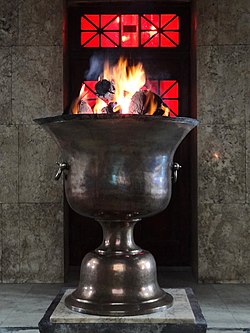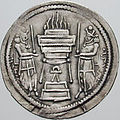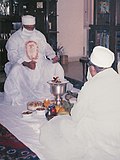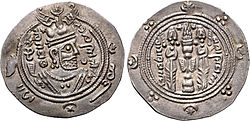Fire temple
A fire temple, Agiary, Atashkadeh (Persian: آتشکده), Atashgah (آتشگاه) or Dar-e Mehr (در مهر) is the place of worship. It is for followers of Zoroastrianism, the ancient religion of Iran (Persia).[1][2][3]
| {{{building_name}}} | |
|---|---|

Burning fire in the Zoroastrian temple of Yazd, Iran. | |
| Basic information | |
| Affiliation | Zoroastrianism |
| Architectural description | |
| Specifications | |
As of 2021[update], there are 167 fire temples. 45 of them are in Mumbai. 105 is in other places in India. 17 are in other countries.[4][5]
Gallery
Picture of the Bahram fire temple.
Iranian Zoroastrians pray at Fire Temple of Baku.
Fire temple of Mazraeh-ye Kalantar.
Fire Temple Media
Fire Temple of Baku in Azerbaijan
A Parsi-Zoroastrian Jashan ceremony (the blessing of a home)
Coin of Farrukhan the Great shows praying of fire temple
Udvada Atash Behram located in Gujarat, India
Silver coin of Yazdegerd II with a fire altar and two attendants
A modern Agiary in Western India
Fire Temple of Yazd in Iran
References
- ↑ Boyce, Mary (1993), "Dar-e Mehr", Encyclopaedia Iranica, vol. 6, Costa Mesa: Mazda Pub, pp. 669–670
- ↑ Kotwal, Firoz M. (1974), "Some Observations on the History of the Parsi Dar-i Mihrs", Bulletin of the School of Oriental and African Studies, 37 (3): 665, doi:10.1017/S0041977X00127557, S2CID 162207182
- ↑ Yasna 62.1; Nyashes 5.7
- ↑ "List of Fire Temples". The Parsi Directory. Retrieved 17 February 2019.
- ↑ Mathai, Kamini (12 July 2010). Parsis go all out to celebrate milestone in Chennai. Chennai: The Times Group. http://timesofindia.indiatimes.com/city/chennai/Parsis-go-all-out-to-celebrate-milestone-in-Chennai/articleshow/6156672.cms. Retrieved 24 Apr 2014.
Sources
- Boyce, Mary (1975), "On the Zoroastrian Temple Cult of Fire", Journal of the American Oriental Society, Journal of the American Oriental Society, Vol. 95, No. 3, 95 (3): 454–465, doi:10.2307/599356, JSTOR 599356
- Boyce, Mary (1987), "Ātaškada", Encyclopaedia Iranica, vol. 2, Costa Mesa: Mazda Pub, pp. 9–10
- Drower, Elizabeth Stephens (1944), "The Role of Fire in Parsi Ritual", Journal of the Royal Anthropological Institute, Royal Anthropological Institute, 74 (1/2): 75–89, doi:10.2307/2844296, JSTOR 2844296
- Gnoli, Gherardo (1993), "Bahram in old and middle Iranian texts", Encyclopaedia Iranica, vol. 3, Costa Mesa: Mazda Pub, pp. 510–513
- Jackson, A. V. Williams (1921). "The Location of the Farnbāg Fire, the Most Ancient of the Zoroastrian Fires". Journal of the American Oriental Society. 41: 81–106. doi:10.2307/593711. ISSN 0003-0279. JSTOR 593711.
- Schippmann, Klaus (1971). Die Iranischen Feuerheiligtümer. Religionsgeschichtliche Versuche und Vorarbeiten (in Deutsch). Berlin: de Gruyter. ISBN 978-3-11-001879-0. OCLC 833142282.
- Shenkar, Michael (2007), "Temple Architecture in the Iranian World before the Macedonian Conquest", Iran and the Caucasus, 11 (2): 169–194, doi:10.1163/157338407X265423
- Shenkar, Michael (2011), "Temple Architecture in the Iranian World in the Hellenistic Period", In Kouremenos, A., Rossi, R., Chandrasekaran, S. (Eds.), from Pella to Gandhara: Hybridisation and Identity in the Art and Architecture of the Hellenistic East: 117–140
- Stausberg, Michael (2004), Die Religion Zarathushtras, vol. III, Stuttgart: Kohlhammer Verlag, ISBN 3-17-017120-8
Other websites
| Wikimedia Commons has media related to Lua error in Module:Commons_link at line 62: attempt to index field 'wikibase' (a nil value).. |

















